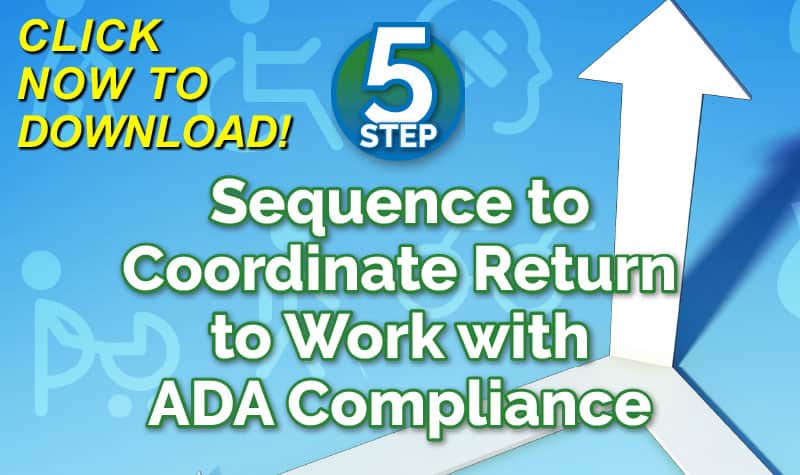Possible Causal Relationships Considerations
Have you ever read a court decision on a workers’ compensation case and had the reaction……. “what?” The following discussion of a court decision definitely creates a “what?” reaction in most people. A press release explained how the Wyoming Supreme Court overturned a lower court decision denying medical benefits to a man who claimed a spinal cord stimulator caused a hernia.
Click Link to Access Free PDF Download
“5-Step Sequence to Coordinate Return-to-Work with ADA Compliance”
In 1993 James L. Ball slipped while walking into a walk-in refrigerator to get some milk. Mr. Ball claimed injury to shoulder, neck, back and right leg. He was awarded permanent total disability. What? Yes – Permanent total disability for a foot slipping. The court description of the accident does not indicate Mr. Ball fell when he slipped.
In 2006 the original spinal cord stimulator failed and a new one was implanted. In 2007, Mr. Ball states he was at home lying in bed when the second spinal cord stimulator caused him to experience a sensation that made him to stand up “real fast” then he fell down, causing a pain in the groin. [Another unwitnessed event?]. Ball went to a Dr. James Shaw who ordered a CT scan that confirmed an inguinal hernia.
Dr. Shaw stated: I would consider this a work-related problem based off the origin of the fall.” What? Inguinal hernia’s are normally caused (according to the medical book) by a:
Risk factors increasing the chances of the hernia developing include advancing age, straining to urinate or pass stools, severe or prolonged coughing and obesity. Mr. Ball’s description of how the hernia occurred does not fit the medical literature. In rare cases a hernia can be caused by falling hard on a blunt object, but there is nothing in the press release that states Ball fell on any blunt object. While Ball clalimed the spinal cord stimulator malfunctioned, there is no mention in the press release stating it was ever confirmed the stimulator malfunctioned. If the spinal cord stimulator malfunctioned as claimed, there is no mention of Ball bringing a products liability claim against the spinal cord manufacturer. What? You have to wonder why no products liability suit was brought if the spinal cord stimulator did malfunction.
The Wyoming Division of Workers Safety and Compensation denied payment for the hernia treatment on the basis it was not related to the original 1993 injury. There is no mention in the press release whether or not the state employee/work comp adjuster had an independent medical examination done to refute the doctor’s statement. Also, there is no mention in the press release whether or not the Division of Workers’ Safety and Compensation did any investigation to determine if Ball was working somewhere else when the hernia occurred. What? You have to wonder why there was no investigation into other causes for the hernia.
Mr. Ball disputed the Division of Workers Safety and Compensation determination. The matter was referred for a contested hearing. At the hearing Ball contended he was entitled to medical benefits for the cost of the hernia treatment claiming the hernia in 2007 was causally related to the 1993 injury. The hearing examiner ruled in Ball’s favor stating the hernia was caused by a fall, the fall was caused by the spinal cord stimulator, the spinal cord stimulator was implanted to treat Ball’s chronic back pain.
The Supreme Court reviewed the work comp claim on whether the hernia occurred “in the course of employment” per the Wyoming work comp statutes. The Supreme Court ruled the position of Ball was in keeping with the language and context of the statute and with the legislative intent. Ball therefore received the medical benefits for the hernia.
In a similar vein, in a very recent New York case, a Cornell University employee, James Smith, had a compensable work-related back injury in 2001. Smith suffered depression that was brought on by the chronic pain related to the back injury. In 2007 Smith committed suicide. The New York State Appellate Court found “sufficient causal relationship” between the suicide, the depression, the chronic pain and the original work comp injury. The court has ruled Ms. Smith is now entitled to death benefits under the New York work comp law
Causal relationships can be tricky. There needs to be in-depth investigation into any possible intervening events that would sever the causal link between the initial injury and the subsequent injury. If the employee can prove that the second event would not have occurred except for the original event (accident), the medical cost and associated indemnity disability cost will be owed by the work comp insurer.
Author Rebecca Shafer, JD, President of Amaxx Risks Solutions, Inc. is a national expert in the field of workers compensation. She is a writer, speaker and website publisher. Her expertise is working with employers to reduce workers compensation costs, and her clients include airlines, healthcare, printing/publishing, pharmaceuticals, retail, hospitality and manufacturing.Contact: RShafer@ReduceYourWorkersComp.com
NEWSLETTER: Workers Comp Resource Center Newsletter
Do not use this information without independent verification. All state laws vary. You should consult with your insurance broker or agent about workers comp issues.



